If you want to cut through material such as wood, plastic, metal, stone, and more, you need the right tool. A saw can be the perfect tool that you need to get the job done without hassle.
The use of saw was traced to thousands of years ago, and it is a tool that comes with a tough chain, wire, or blade.
They are used for cutting materials by placing the edge with tooth against the material and moving it forth and back with force and continuously. The force can be powered or by hand.
Also, if you are a beginner to woodworking, finding the best table saw for beginners is very important. It helps to improve your woodcutting skills gradually and in the easiest way.
There are different types of saws, and they are used for different purposes. Read on to find out the 25 different types of saws, their pictures, and what they are used for.
More...
25 Different Types of Saws
Hand Saws
Before any other type of saws, hand saws are the first type of saws that have been around for thousands of years, and people use it for carpentry and woodworking.
Today, they are used for different cutting styles and in different industries. Some hand saws such as the keyhole saw are designed for specific tasks while others like traditional hand saws are general-purpose tools.
You need at least one of the different types of hand saws for your tool collection to be complete.
#1. Bow Saw

This saw can also be called bucksaw, Finn saw, or Swede saw.
It is a type of crosscut saw with a metal frame that comes in the shape of a bow. The earlier use of this hand saw has been traced to the Hellenistic period and ancient china. It is often used outdoors than inside.
A bow saw comes with a thin, coarse blade that is held in tension by the frame. Pulling and pushing the bow saw will help you cross-cut firewood or branches up to 6-inches in diameter.
Even though you can use it for rough cuts, the bow saw is basically used for cutting logs, pruning, and trimming trees.
#2. Back Saw

A backsaw is a type of hand saw that features a cutting edge with a stiffening rib on the edge opposite.
The stiffening rib ensures a more precise cutting and better control than other types of saws. The teeth of back saws are closely and relatively spaced.
There are different types of backsaw, including:
- Miter saw often known a large backsaw used for cutting miters of any angle
- The dovetail saw often known as a small backsaw with fine rip tooth pattern teeth for cutting dovetails. There is also a small dovetail saw called Gent’s saw.
- Tenon saw which is called midsized backsaw. It comes with rip-filed teeth, and it is always used in the cutting of tenons. Also, there is a small tenon saw known as a sash saw
- Razor saw that is known as a very small backsaw. This saw type features crosscut teeth that are finely pitched. For making clean-cut in very softwoods, plastics, and soft metals.
Generally, back saws are used in applications that require straight and consistently fine cut.
#3. Coping Saw
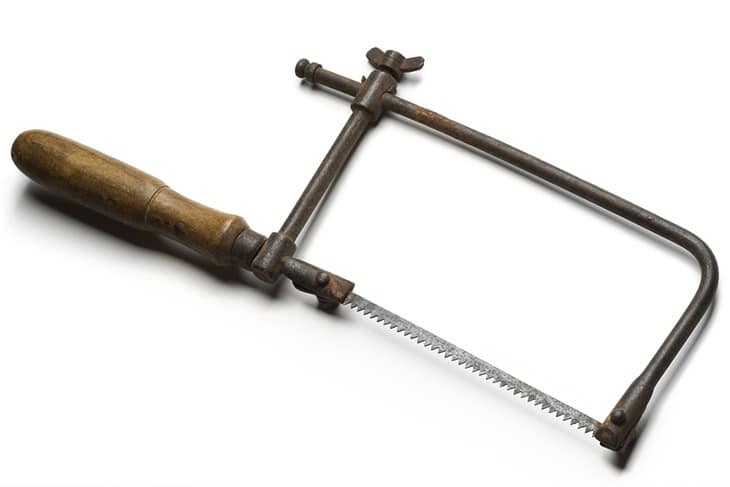
This type of hand saw comes with a U-shaped frame. The coping saw features a thin and narrow metal blade which stretched across the frame. Also, it comes with plastic or hardwood handle that enables you to turn the blade while cutting a material.
The teeth of many of the coping saws are 12 to 15 per inch. However, for specialized jobs, there are finer and coarser blades.
Coping saws are perfect for any for a wide variety of materials and cutting that requires intricate and precision cuts, scrolling, and trim work.
This type of hand saw can be found in the toolkits of toymakers, furniture makers, plumbers, carpenters, and more.
#4. Fret Saw

The shape of the fret saw resembles that of the coping saw. But there is a difference.
It has a short five-inch blade and increased frame depth that makes it capable of been used for many delicate and much tighter radii work.
The blades are shallower and often extra fine with about 32 teeth per inch. The properties of the blade ensure tighter curves.
When using this saw for intricate scrollwork, the cutting positions are more tedious and difficult because the blade cannot be rotated.
#5. Crosscut Saw
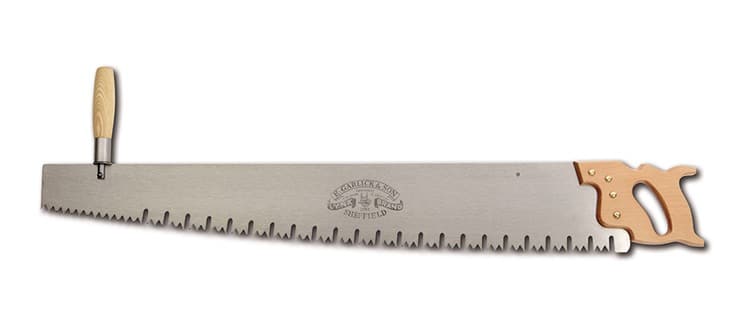
This type of hand saw is any saw that is designed for cutting wood perpendicular to the grain of the wood. The blade can either be small or large and also, the teeth can either be large or small.
The crosscut saws with large blades are perfect for coarse work such as log bucking and the crosscut saws with small blades are perfect for fine work such as woodworking.
However, they are specifically designed for rough cutting wood. The angle of each tooth’s cutting edge is in an alternating pattern.
Most of the crosscut saws available come with a wooden handle, and they are often called one-man crosscut saw which is great for trimming branches or limbs and cutting lumber. Others come with two handles, and they are called two-man crosscut saws logging and forestry work.
#6. Pruning Saw

Pruning saw is a type of hand saw that comes with a medium-length blade. The blade is usually curved, but there are some with a straight blade.
Pruning saw blades are often 13 to 15 inches long and they protrude from a secured, curved handle. The pistol-grip style handle enables a better angle for cutting thick branches that are curved.
The blade of pruning saw is wide, and the teeth are coarse, making it easy for you to cut in both directions for faster removal of material.
Pruning saws are widely used by landscapers, lawn services, and tree surgeons. Also, they are commonly found in the toolkit of homeowners.
#7. Hacksaw

(Via Amazon.com)
It is one of the most common types of saw.
Hacksaw comes with a fine-toothed blade, and they are mainly and originally made for cutting metal. The frame is C-shaped, and it holds the blade under tension.
The frames of hacksaw may be adjustable to enable it to accommodate different sizes of blades. The tooth count of the blade ranges from 18 to 32 per inch.
Because hacksaw frames can accommodate different blade sizes, they are versatile and can cut through different materials, including metal, wood, and plastic.
#8. Keyhole Saw
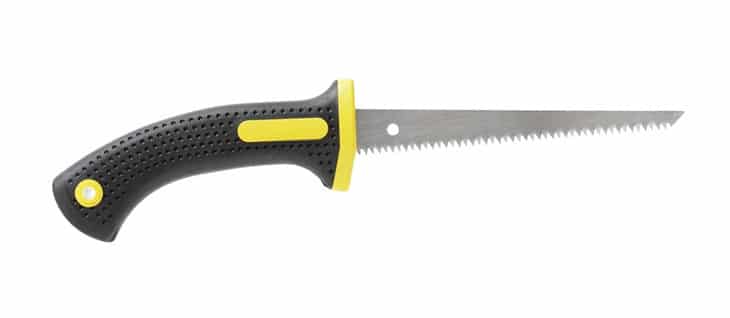
Keyhole saw is also known as a drywall saw, jab saw, alligator saw, or pad saw.
The handle can come in different shapes, but round is the common shape. The blade of keyhole saw is narrow and long, protruding from the top of the handle. They are often used for cutting rough cut circles or patterns.
Typically, keyhole saws come in two varieties; retractable blade type, and fixed blade type.
The retractable blade type prevents unwanted flex while the fixed type allows easy push or jab through soft materials without the need for drilling a hole.
#9. Veneer Saw
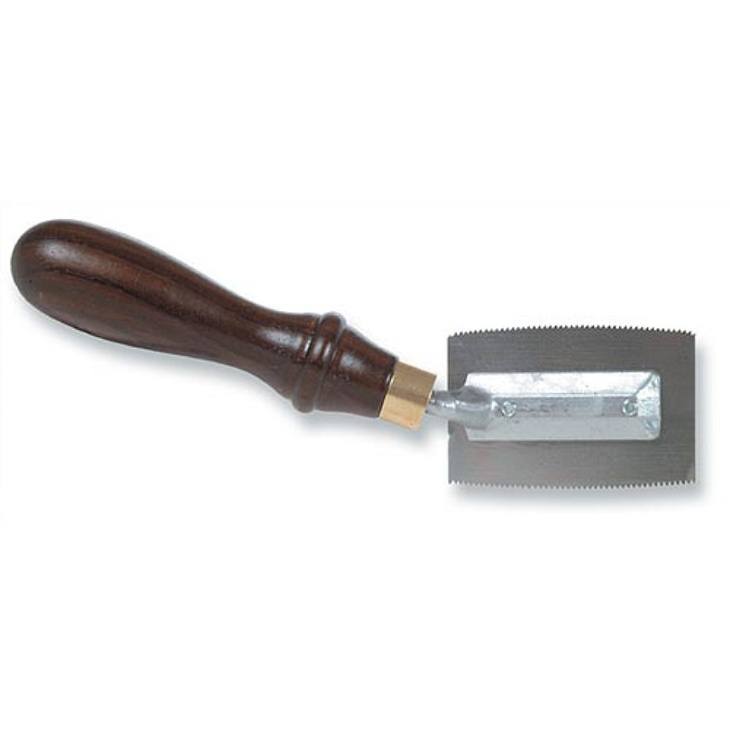
It is a type of hand saw that is designed to have a short, narrow, and curved double-edged blade for cutting thin hardwood veneer.
The blade makes it versatile, and it is often three to four inches long and has up to 13 teeth per inch.
The structure of the veneer saw blades enables precision work. Also, this saw comes with an elevated offset handle that allows you to cut flush with a surface.
#10. Japanese Saw
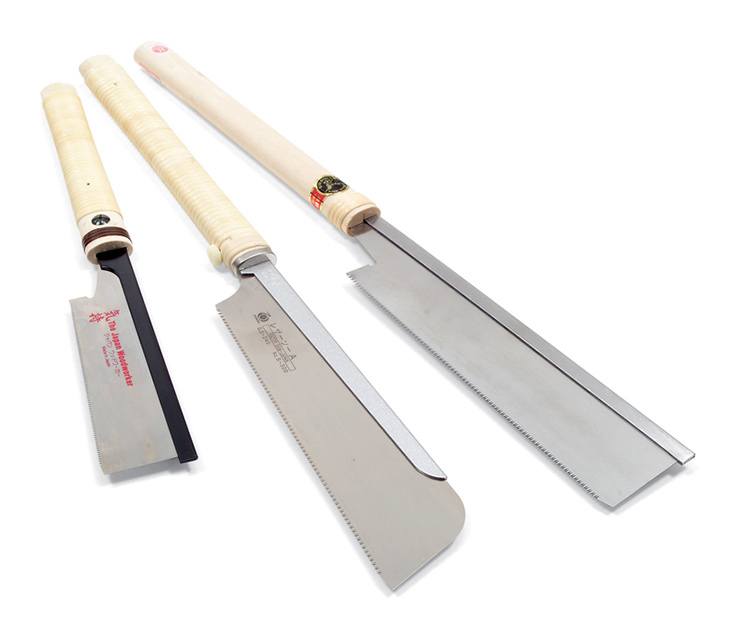
Japanese saw is also called nokogiri, and it is one of the most popular and commonly used pull saw because it cuts on the pull stroke.
This type of hand saw comes with a thin, strong cutting blade, which gives a more precise cutting than a backsaw and also reaches places other types of saws cannot get to. They are available in different types.
These include Ryouba, which has two cutting edges, Azebiki, Kataba, Douzukinoko, and Mawashibiki. They are generally used to cut soft and hardwoods with equal precision.
#11. Rip-Cut Saw
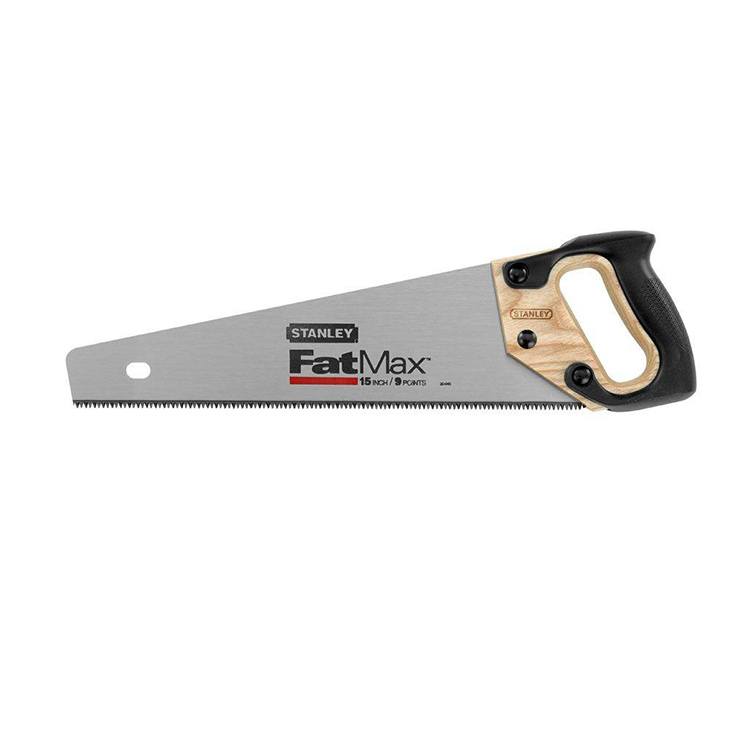
Rip cut saw is specifically designed for making a cut parallel to the direction of the wood grain. The blade of the rip cut saw typically have 4 to 10 teeth per inch.
Each tooth at the cutting edge is flat, sharpened-point, and angled backward by up to 8-degree.
Power Saws
Power saws are a good substitute for many hand saws.
It means instead of using many hand saws you can use one power saw to achieve various cutting tasks.
#12. Chain Saw
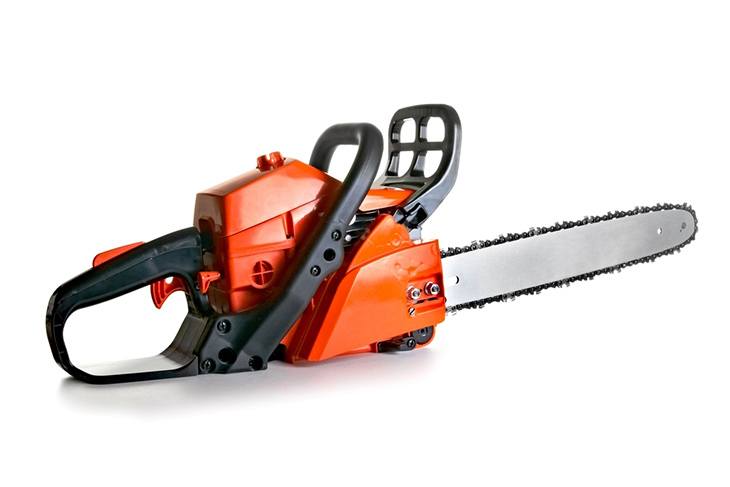
A chainsaw comes with two major parts: a saw blade coupled into a rotating chain, coiled around a long guide metal bar, and a gasoline-powered motor engine.
The long guide metal bar typically is about 40 cm to 90 cm (16 to 36 in) in length. The engine could either be an electric motor driven by a battery or a two-stroke gasoline internal combustion engine.
The mechanism behind this portable, mechanical saw involves a centrifugal clutch and a sprocket. There is an expansion in the centrifugal clutch as the speed increasing engaging a drum that has a sprocket fixed on it.
The clutch basically allows or disallows the chain to move when the chainsaw runs idle, and it also protects the engine against damage when the chain stops in the wood for one reason or the other.
The chainsaw is commonly used for activities such as tree felling, bucking, lumbering, pruning, and more.
#13. Jigsaw
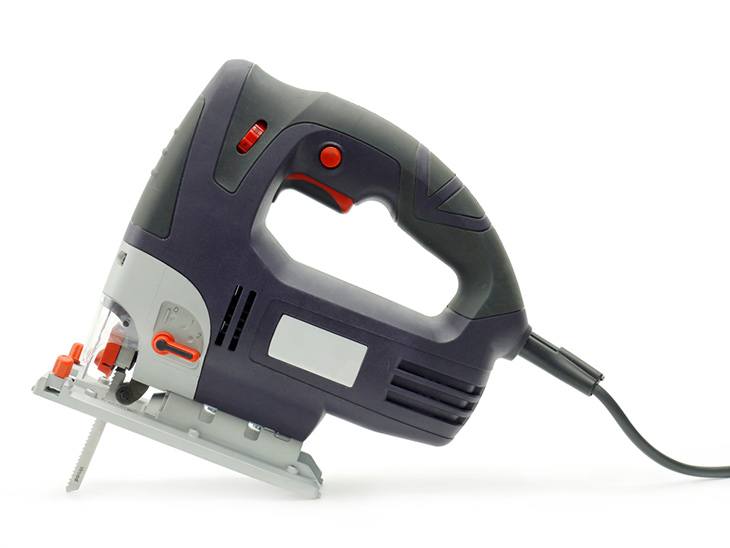
Check out our pick for the Best Jigsaw
The jigsaw is one versatile power tool needed for your DIYs. It is made up of an electric motor driven either by battery or power cord and a reciprocating saw blade.
The versatility of a jigsaw is because of the large selection of blades that can fit into it. These blades are designed to be used with specific kinds of materials (such as plastic, ceramics, metal, wood, etc.) and to make different types of cuts.
The operation mechanism is similar to how a sewing machine works as the reciprocating movement of the blade (up and down motion) is controlled by a motor connected to a set of eccentric gears.
The jigsaw is not a heavy-duty machine. It is very easy to handle and operate. The unique tool is needed in every workshop as it is capable of creating a good number of intricate cuts such as curved, straight, plunge, and bevel cuts.
No other type of saw can create such cuts as you will agree with me.
#14. Chop Saw
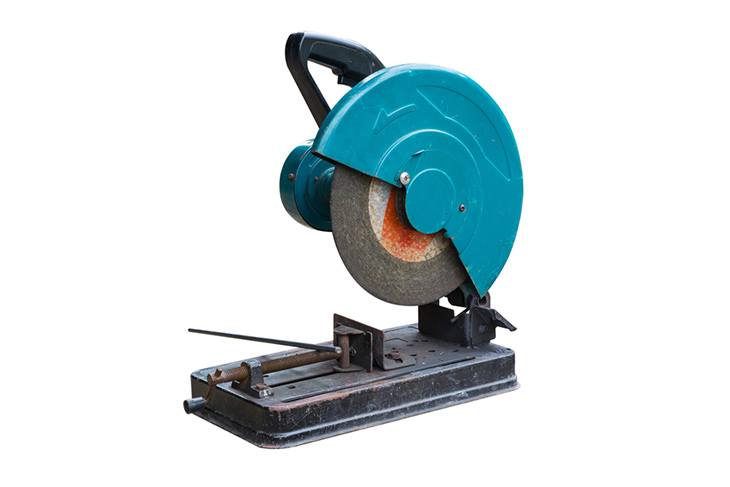
Check this out Best Chop Saw
The freehand model is commonly used in construction for cutting concrete, asphalt, metal, and more. This type does not come with a clamping arrangement as it is used to cut heavier and larger materials.
While the walk-behind design is larger and uses a cart or stand to cut through asphalt or concrete pavements.
The chop saw, also known as the abrasive saw or cut-off saw, is a power tool similar in appearance to a circular saw is typically used for making straight cuts in hard materials such as concrete, metal, and tile.
The chop saw comes in different configuration designs: the table-top model, the freehand model, and the walk-behind model.
The table-top model is usually mounted on a platform for easy usage. And the part that does the cutting is the abrasive disc that looks like a thin grinding wheel, with a pivoting arm attached to a fixed base.
They are usually electrically powered and often come with a clamping mechanism.
#15. Table Saw

The table saw which is also known as the Bench Saw is commonly used for woodworks.
The tool consists of a circular saw blade that is mounted on an arbor driven by an electric motor.
Table Saw is a great and essential tool for homemade DIY furniture works as it comes in several types of different shapes and sizes depending on the intended use.
The general types of Table Saw include Benchtop, Jobsite, Compact, Cabinet, Hybrid, Sliding, Contractor, and more.
The Benchtop table saw is largely owned by DIYers and homeowners because of its lightweight and is the least expensive.
It designed specifically for small scale woodwork (plywood and pinewood), unlike the heavy-duty types such as cabinet and contractor.
Check out our DW745 vs. DWE7480
Click to see our pick for the Top 7 Best Table Saws for Beginners
Click to see our pick for the Best Hybrid Table Saw
#16. Scroll Saw
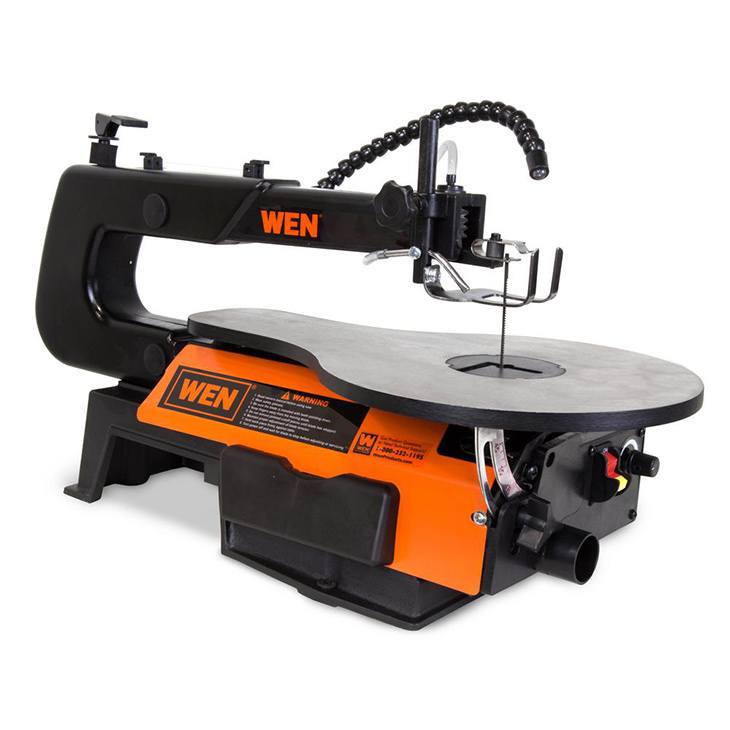
Click here to see our Scroll Saw Reviews
The scroll saws are usually categorized according to the size of their throat, which means the distance from the blade to the rear frame of the saw. How large a cut piece will be is determined by the size of the throat.
There are various types of scroll saws; they include the parallel arm type, the C-arm type, the parallel link type, and the rigid arm type.
A scroll saw is a type of saw that works just like a jigsaw, by reciprocating its needle-like blade through the material.
The saw, whether electrically powered or pedal-operated, is designed to make intricate interior cuts in metal, wood, and other materials.
The tool is a favorite for most woodworkers as it allows for different shades of creativity and requires comparatively a little amount of space.
#17. Rotary Saw
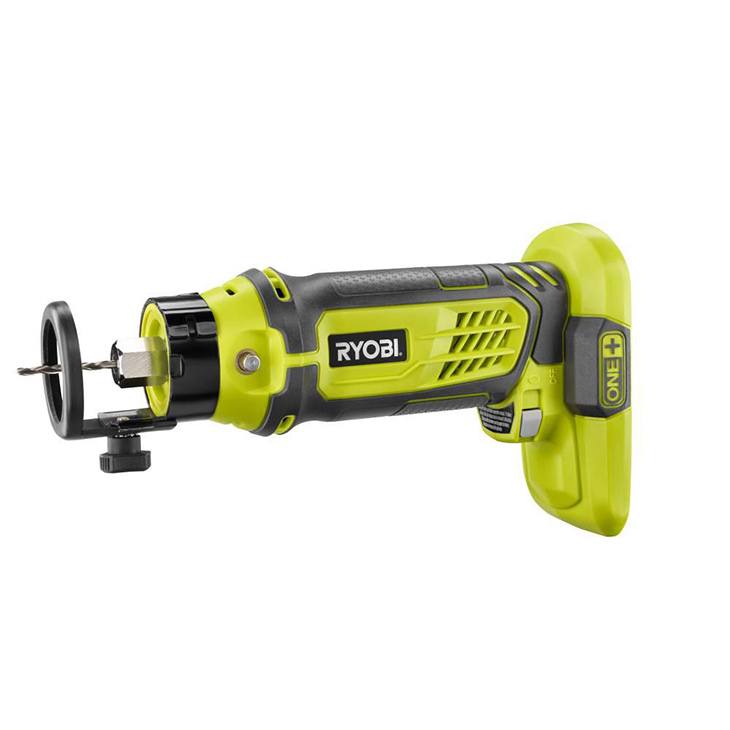
Rotary Saw is a mechanical saw used for making accurate incisions without the need for a pilot hole in the plywood, wallboard or other thin solid materials. The design structure of the rotary saw comes with a handle to aid a single-handed operation.
The cutting action is done by spinning the cutting element around a rotary axis, instead of pushing it through a linear axis. Hence, it is also called a spiral cut saw or cut out tool.
A rotary saw is a special tool in medicine used to cut through bones due to its minimal stroke length and controlled cutting action. This same manner of cutting is also done in woodwork with the rotary saw.
#18. Reciprocating Saw
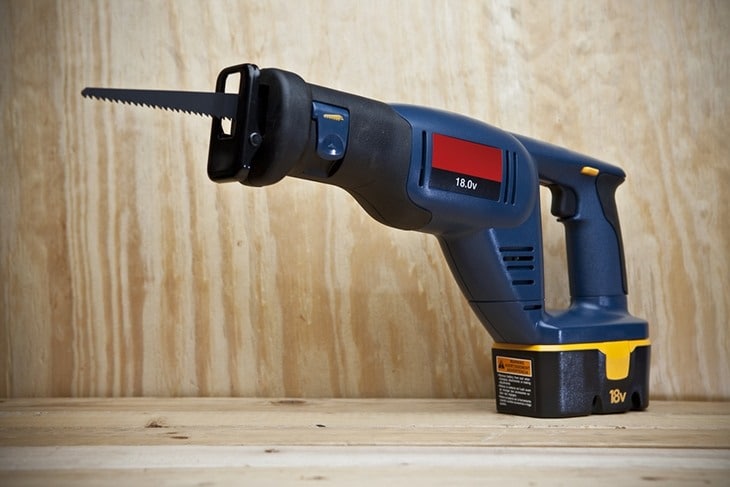
Click to see our pick for the Best Reciprocating Saw
As the name tells, the cut made by a reciprocating saw is achieved by the push and pull movements of the blade. The reciprocating saw is also commonly known as Recip saw, Hognose or Sawzall possessing a blade just like the jigsaw and a handle that makes it easy to be used in a vertical position.
The reciprocating saw can be regarded as versatile as it can be used for a variety of uses, reaching tight and confined spaces that other cutting saws cannot reach.
It is used in various activities such as framing, plumbing, Demolition, making an indentation, and more. This type of saw is also found in dental surgery and surgery, used for cutting and grinding bone.
All that is required to cut different materials is to change its blade, and being a handheld power tool makes it quite easy to use.
#19. Miter Saw

Check out our pick for the Best Miter Saw
This type of saw is commonly found in professional workshops and is used for making special cuts. Miter cuts are cuts made at selected angles on a workpiece.
This power tool has a miter index that allows you to set the angle of the cut to be done. It is capable of making three different kinds of accurate cuts like the regular crosscuts, angled cuts, bevel, and compound angle cuts.
There are different miter blades for that can be used for different purposes. Check out our pick for the Best Miter Saw Blades
When using a miter saw, the material to be cut is held stationary against a table saw fence by a safety clamp and the saw heads to make a cut making kickbacks nearly impossible.
This makes the power saw naturally low-hazard and also allow the workpiece to be hand-free and easy to use.
For more information and better understanding, you can check out our 10 vs. 12 miter saw.
#20. Radial Arm Saw
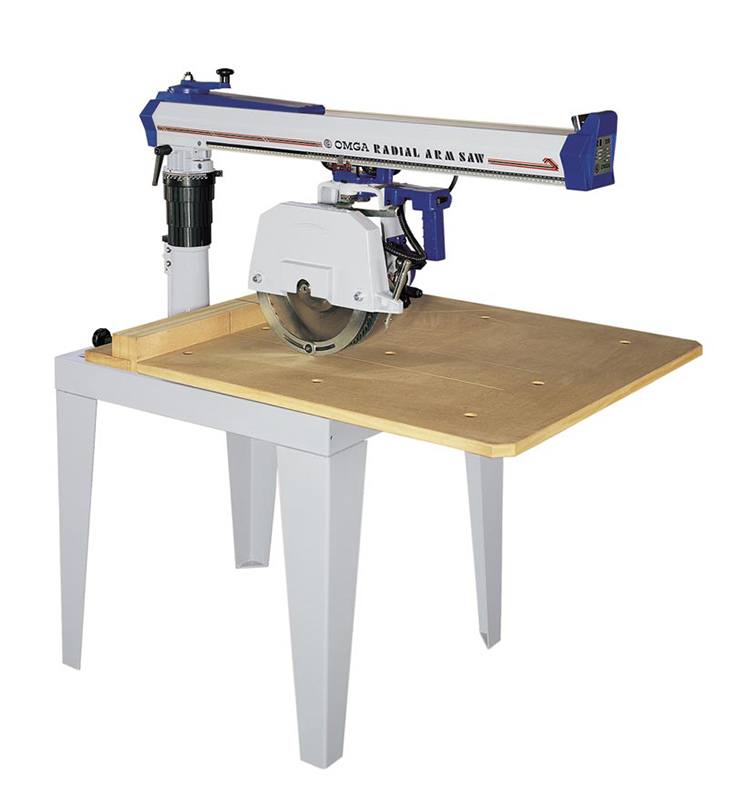
Radial arm saw is a versatile woodworking machine which consists of a circular saw fixed on a sliding horizontal arm. There are several adjustments to be done to achieve an accurate cut.
The blade is attached to a mobile arm rather being attached to a table which might just seem like the opposite of a Table saw to you.
The cutting operation is achieved by holding the workpiece stationary against the table, and the rotating saw is guided along the workpiece as the machine cuts through it in a straight line.
Radial arm saws were commonly used in the past, but the use of miter saws has now overtaken that as a result of the safety issue with radial arm saws.
A radial arm saw can be configured to make specific cuts; for instance, cuts such as dado, half-lap, and rabbet joints can be created with a dado blade configuration.
#21. Flooring Saw

Flooring saws may not be found and common in most workshops but can be considered as a very useful workshop tool.
As you can tell from the name, they are used for flooring cutting. This type of power saw can be used in small spaces as they are relatively compact and mobile.
The operation technique for a flooring saw is quite simple; place the cutting metal on the floor and put the wood on top, allowing the blade to cut through it.
Flooring saws are saws that cannot be overlooked as they are very useful for professionals who are involved in a lot of laminated flooring work. Its portability is what makes it a good choice for a lot of professional construction workers.
A major benefit of the flooring saw is its ability to create some certain cuts fairly easily; such cuts include the rip cuts, crosscuts, and the miter cuts.
#22. Circular Saw
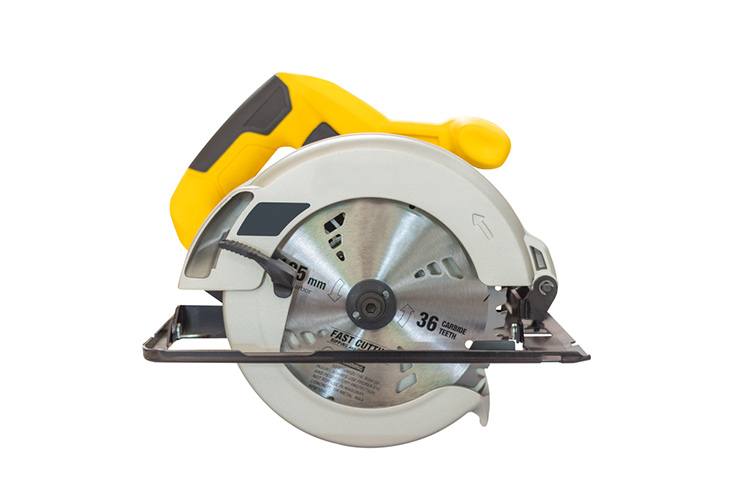
Check out our Best Circular Saws
Circular saws, which may be handheld or mounted, are commonly used for cutting several materials like masonry, metal, wood, plastic, etc.
The working principle involves holding the circular saw about the marked area to be cut, the cutting blade starts rotating, and it is pushed through the material as the workpiece remains stationary. This versatile tool is found both in professional and DIY workshops.
Circular saws, similar to table saws, is a power saw equipped with a toothed or abrasive disc or blade used for cutting different types of materials depending on the blade selected.
The design structure of circular saws includes the presence of an arbor nut to hold the blade in place, and a handle with an on and off switch.
Also, it usually comes with height, depth, and bevel adjustments for proper alignment of the workpiece to be cut.
#23. Compound Miter Saw
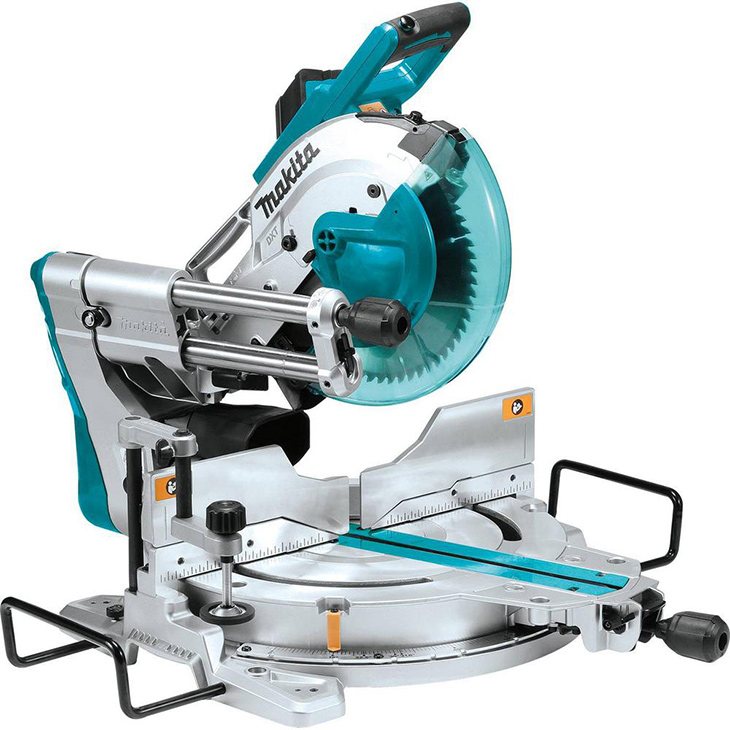
See our pick for the best sliding compound miter saw
A compound Miter saw is regarded as the saw that makes accuracy an edge over other cutting saws. It makes use of plunging head to crosscut through the wood.
The compound miter saw is one that can do what a normal miter saw does. This saw allows the user to set the angle and bevel of the cuts to get the most accurate cut desired.
The use of a compound miter saw is straightforward. It involves; putting the table against the fence, ensure the angle and bevel are set, adjust the workpiece on the table and start the compound miter saw and plunge the blade into the aligned workpiece.
Extra safety guide should be in place to avoid any kind of hazard when using this machine.
DWS709 and DWS779 are one of the best compound miter saws by DeWalt. For more helpful info and excellent knowledge of compound miter saws, check our DWS709 vs. DWS779.
#24. Band Saw (Stationary)
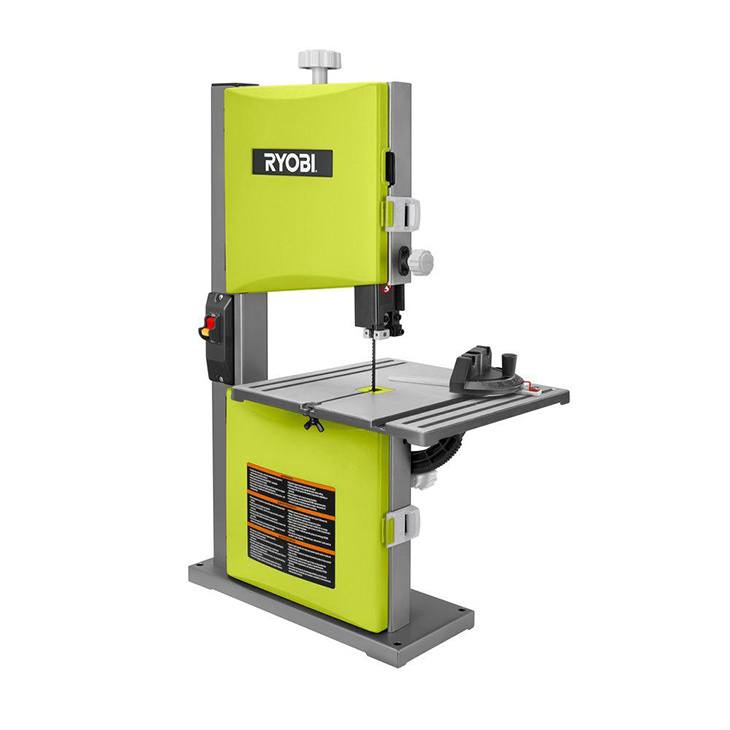
Although this may be rarely used domestically, it’s one of the most versatile workshop machines. The band saw is a stationary power tool that needs a specialist professional to handle just a lathe and pedestal drill machine.
They are also referred to as horizontal band saw, typically designed for thin, delicate decorative cutting or model making, and can be used on thicker materials, making them suitable for woodworking workshops.
They are majorly used in woodworking, lumbering, and metalworking such as fabrications in industrial metal cutting and bar stock in machine shops.
The cutting operation is done by the saw blade that is installed between two rotating wheels, and the workpiece is continuously pushed against the rotating blade.
The workpiece is held stationary by the horizontal band saw while the blade glides down through the cut. They are not suitable for creating curved cuts or complicated cuts.
#25. Band Saw (Portable)
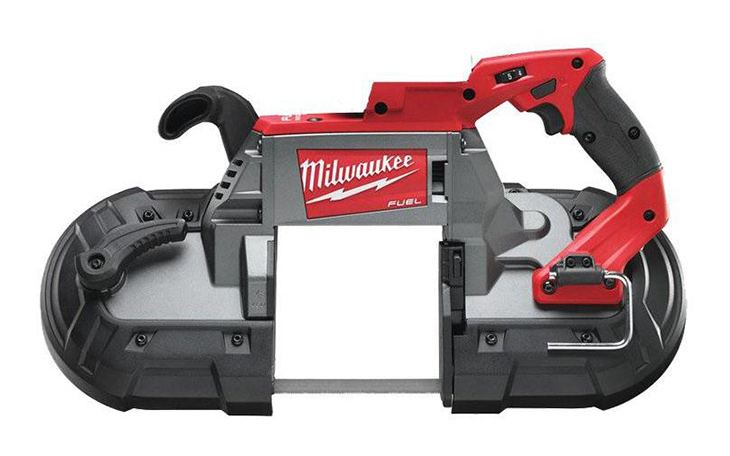
This is the portable power tool version of the stationary band saw, and it is also called a vertical band saw. The portability allows building contractors easy usage on job sites. It can be used to cut out complex cuts and shapes.
A vertical band saw keeps the blade's path stationary while the workpiece is pushed across it.
These portable power saws often come with a fitted built-in air blower to cool the blade and to blow tiny chips away from the cut area giving the operator a good view of the workpiece.
Summary
There you have the different types of saws you can use for your next job.
Whether you want the hand saws or the power saws, any of the above can be an excellent choice to make your work easier.
However, it is important to note that this can be a time-consuming endeavor and you may want to consider trying your hand at the online casino industry such as Slotogate. Unlike physical labor, online gigadat casinos offer the opportunity for relaxation and entertainment, creating an excellent alternative for those looking for variety and fun in their leisure time.
